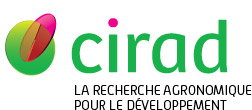Piponiot Camille, Cogne Marguerite, Freycon Vincent, Thoumazeau Alexis, Gusmão Marçal, Peltier Régis. 2025. Traditional agroforestry systems in Timor-Leste can store large amounts of carbon in both soil and biomass. Agroforestry Systems, 99:138, 16 p.
|
Version publiée
- Anglais
Sous licence  . .
s10457-025-01222-8.pdf Télécharger (1MB) | Prévisualisation |
Url - jeu de données - Dataverse Cirad : https://doi.org/10.18167/DVN1/QCXWIY
Résumé : Agroforestry has the potential to make agriculture more resilient while improving carbon sequestration by incorporating trees and/or other woody perennials into agricultural land, thereby diversifying landscapes. Traditional agricultural systems in tropical areas often include trees, but their carbon sequestration potential is not always well described, hindering their inclusion in climate change mitigation strategies. In this study, we quantified carbon storage in both vegetation biomass and soil in five traditional agroforestry systems (AFS) in Timor-Leste, namely cropping systems with fallow (CF), silvopastures (SP), young agroforests (YA), home gardens (HG), and forest gardens (FG). Our results show that these traditional AFS can store large amounts of carbon, with the average total carbon stocks (soil and biomass) being 155 Mg C ha−1. The AFS with the highest total carbon stocks (FG) stored an average of 213 Mg C ha−1. The average stocks in the other AFS were 108 Mg C ha−1 in CF, 158 Mg C ha−1 in SP, 134 Mg C ha−1 in YA, and 171 Mg C ha−1 in HG. Biomass carbon stocks varied substantially between AFS, while soil carbon stocks were less variable between AFS but more site-dependent. We found no relationship between the amount of carbon stored in biomass and soil. Our results highlight the diversity of traditional AFS in Timor-Leste and their carbon sequestration capacity. These results could provide an important baseline for the inclusion of AFS in Timor-Leste's climate change mitigation strategy, and could serve as a reference for future AFS studies in different agro-climates of Timor-Leste.
Mots-clés Agrovoc : séquestration du carbone, agroforesterie, carbone, changement climatique, biomasse, atténuation des effets du changement climatique, déboisement, stockage, matière organique du sol, biodiversité, système sylvopastoral, cycle du carbone
Mots-clés géographiques Agrovoc : Timor-Leste
Mots-clés libres : Vegetation biomass, Soil organic carbon, Farming systems, Climate change mitigation, South East Asia
Agences de financement européennes : European Commission
Agences de financement hors UE : German Federal Ministry for Economic Cooperation and Development, Bundesministerium für Wirtschaftliche Zusammenarbeit und Entwicklung, Deutsche Gesellschaft für Internationale Zusammenarbeit
Projets sur financement : (EU) Partnership for sustainable agroforestry
Auteurs et affiliations
-
Piponiot Camille, CIRAD-ES-UPR Forêts et sociétés (FRA)
 ORCID: 0000-0002-3473-1982 - auteur correspondant
ORCID: 0000-0002-3473-1982 - auteur correspondant
- Cogne Marguerite, Université de Montpellier (FRA)
- Freycon Vincent, CIRAD-ES-UPR Forêts et sociétés (FRA)
-
Thoumazeau Alexis, CIRAD-PERSYST-UMR ABSys (THA)
 ORCID: 0000-0003-0758-139X
ORCID: 0000-0003-0758-139X
- Gusmão Marçal, UNTL (TLS)
-
Peltier Régis, CIRAD-ES-UPR Forêts et sociétés (FRA)
 ORCID: 0000-0002-8110-7322
ORCID: 0000-0002-8110-7322
Source : Cirad-Agritrop (https://agritrop.cirad.fr/613867/)
[ Page générée et mise en cache le 2025-09-22 ]




